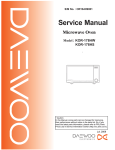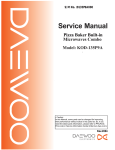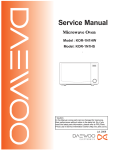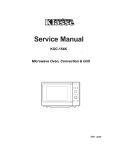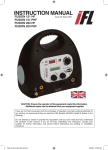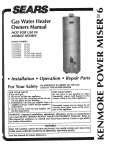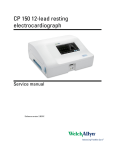Download Daewoo KOT-150S0A Service manual
Transcript
S/M No. : OT1G0A0001 Service Manual Microwave Oven & Hood Exhaust Model : KOT-1G0W KOT-1G0B KOT-1G0S • Caution: In this Manual, some parts can be changed for improving, their performance without notice in the parts list. So, if you need the latest parts information, please refer to PPL(Parts Price List) in Service Information Center (http://svc.dwe.co.kr). Sep. 2007 PRECAUTIONS TO BE OBSERVED BEFORE AND DURING SERVICING TO AVOID POSSIBLE EXPOSURE TO EXCESSIVE MICROWAVE ENERGY (a) Do not operate or allow the oven to be operated with the door open. (b) Make the following safety checks on all ovens to be serviced before activating the magnetron or other microwave source, and make repairs as necessary: (1) Interlock operation, (2) Proper door closing, (3) Seal and sealing surfaces (arcing, wear, and other damage), (4) Damage to or loosening of hinges and latches, (5) Evidence of dropping or abuse. (c) Before turning on the microwave oven for any service test or inspection within the microwave generating compartments, check the magnetron, wave guide or transmission line, and cavity for proper alignment, integrity, and connections. (d) Any defective or misadjusted components in the interlock, monitor, door seal, and microwave generation and transmission systems shall be repaired, replaced, or adjusted by procedures described in this manual before the oven is released to the owner. (e) A microwave leakage check to verify compliance with the Federal performance standard should be performed on each oven prior to release to the owner. TABLE OF CONTENTS SAFETY AND PRECAUTIONS ...........................................................................................................................................2 SPECIFICATIONS ...............................................................................................................................................................3 EXTERNAL VIEW................................................................................................................................................................4 INSTALLATION ...................................................................................................................................................................4 OPERATIONS AND FUNCTIONS.......................................................................................................................................4 DISASSEMBLY AND ASSEMBLY......................................................................................................................................5 TROUBLE SHOOTING GUIDE .........................................................................................................................................28 MEASUREMENT AND TEST ............................................................................................................................................30 WIRING DIAGRAM............................................................................................................................................................37 PRINTED CIRCUIT BOARD..............................................................................................................................................41 EXPLODED VIEW AND PARTS LIST...............................................................................................................................50 1 SAFETY AND PRECAUTIONS CAUTION : This Device is to be Serviced Only by Properly Qualified Service Personnel. Consult the Service Manual for Proper Service Procedures to Assure Continued Safey Operation and for Precautions to be Taken to Avoid Possible Exposure to Excessive Microwave Energy. 1. FOR SAFE OPERATION Damage that allows the microwave energy (that cooks or heats the food) to escape will result in poor cooking and may cause serious bodily injury to the operator. IF ANY OF THE FOLLOWING CONDITIONS EXIST, OPERATOR MUST NOT USE THE APPLIANCE.(Only a trained service personnel should make repairs.) 1) A broken door hinge. 2) A broken door viewing screen. 3) A broken front panel, oven cavity. 4) A loosened door lock. 5) A broken door lock. The door gasket plate and oven cavity surface should be kept clean. No grease, soil or spatter should be allowed to build up on these surfaces or inside the oven. DO NOT ATTEMPT TO OPERATE THIS APPLIANCE WITH THE DOOR OPEN. The microwave oven has concealed switches to make sure the power is turned off when the door is opened. Do not attempt to defeat them. DO NOT ATTEMPT TO SERVICE THIS APPLIANCE UNTIL YOU HAVE READ THIS SERVICE MANUAL. 2. FOR SAFE SERVICE PROCEDURES. 1) If the oven is operative prior to servicing, a microwave emission check should be performed prior to servicing the oven. 2) If any certified oven unit is found to have excessive emission level 5mW/㎠, the service person should: (a) inform the manufacturer, importer or assembler, (b) repair the unit at no cost to the owner, (c) attempt to ascertain the cause of the excessive leakage, (d) tell the owner of the unit not to use the unit until the oven has been brought into compliance. 3) If the oven operates with the door open, the service person should tell the user not to operate the oven and contact the manufacturer and CDRH immediately. CAUTION : Microwave Radiation Personnel Should Be Exposed to the Microwave Energy Which May Radiat from the Magnetron or Other Microwave Generating device if it is Improperly Used or Connected. All Input and Output Microwave Connections, Wave-Guide, Flanges and Gaskets Must be Secure. Never Operate the Device Without a Microwave Energy Absorbing Load Attached. Never Look Into an Openwaveguide or Antenna While the Device is Energized. 2 SPECIFICATIONS Model KOT-1G0A / KOT-1G4U Power Supply 120V ~ 60 Hz, SINGLE PHASE WITH GROUNDING Rated Current 14A Microwave Power Consumption 1600W, Max. Output Power (IEC 705) 1000W Frequency 2450 MHz Outside Dimensions (WxHxD) 760x427x363 mm ( 29.9" x 16.8" x 14.3" ) Cavity Dimensions (WxHxD) 514x248x347 mm ( 20.2" x 9.7" x 13.7" ) Net Weight 21.8Kg (48 lbs) / 22.8Kg (50.3 lbs) Timer Approx. 99 min 99sec Power Selections 10 Levels Cavity Volume 1.6 Cu. Ft. Magnetron cooling Forced air Microwave Distribution turntable Rectification voltage doubler, half-wave. Door Sealing Choke System Safety Device Cavity Thermostat open : 212℉/100℃, reset : 140℉/60℃ Bottom Thermostat open : 203℉/95℃, reset : 32℉/0℃ Hood Thermostat open : 104℉/40℃, reset : 132.8℉/56℃ Line Fuse 20 A Door Interlock Switches Primary Interlock Switch. Secondary Interlock Switch. Interlock Monitor. Magnetron type RM228JFP (or 2M218JFP) High Voltage Capacitor 0.98uf 2.1KV AC High Voltage Diode 350 mA, 9.0 KV Cook-top Lamp 125V, 30W Cavity Lamp 125V, 30W Tray Glass * SPECIFICATIONS ARE SUBJECT TO CHANGE WITHOUT NOTICE. 3 EXTERNAL VIEW ; REFER TO THE INSTALLATION GUIDE INSTALLATION ; REFER TO THE INSTALLATION GUIDE OPERATIONS AND FUNCTIONS ; REFER TO THE INSTALLATION GUIDE 4 DISASSEMBLY AND ASSEMBLY Caution to be observed when trouble shooting Unlike many other appliances, the microwave oven is high-voltage, high-current equipment. It is completely safe during normal operation. However, carelessness in servicing the oven can result in an electric shock or possible danger from a short circuit. You are asked to observe the following precautions carefully. 1. Always remove the power plug from the outlet before servicing. 2. Use an insulated screwdriver and wear rubber gloves when servicing the high voltage side. 3. Discharge the high voltage capacitor before touching any oven components or wiring. 1) Check the grounding. Do not operate on a two-wire extension cord. It is imperative, therefore, to make sure it is grounded properly before beginning repair work. 2) Warning about the electric charge in the high voltage capacitor. for about 30 seconds after the operation has stopped an electric charge remains in the high voltage capacitor. When replacing or checking parts, short between oven chassis and the negative high terminal of the high voltage capacitor by using a properly insulated screwdriver to discharge. 4. When the 20A fuse is blown due to the operation for the monitor switch; replace primary interlock switch, secondary interlock switch and interlock monitor switch. 5. After repair or replacement of parts, make sure that the screws are properly tightened, and all electrical connections are tightened. 6. Do not operate without cabinet. SHORT CAUTION : Service personnel should remove their watches whenever working close to or replacing the magnetron. CAUTION : When servicing the appliance, take care when touching or replacing high potential parts because of electric shock or exposing microwave. These parts are as follows - HV Transformer, Magnetron, HV Capacitor, HV Diode. 5 1. GENERAL -REMOVING / REINSTALLING WARNING : Personal Injury Hazard Disconnect from the power supply before servicing the unit. Failure to do so could result in electric shock or other personal injury. CAUTION : Personal Injury Hazard Because of the weight and size of the microwave oven, two people are required to safely move and install it. Failure to do so could result in personal injury. -CABINET CABINET REMOVAL Refer to FIG. 1 for the following steps: 1. Remove the microwave oven from its mounting location and set it on a protected (padded) work surface. 2. Remove the two screws from the top of the microwave oven that secure the vent grille to the oven, and pull the top of the vent grille out so the tabs are from their slots, and remove it. 3. Remove 1 screw from the vent motor cover. 4. Remove the remaining 13 screws from the top, side and rear of the cabinet. Slide the cabinet back and unhook it from the side tabs, then slide the power cord into the cabinet, and lift the cabinet from the oven. Proceed to the section for the component you wish to service. CABINET INSTALLATION Refer to FIG. 1 for the following steps: 1. Position the cabinet over the top of the microwave oven and slide the power cord all the way through the top opening. 2. Slide the cabinet forward so that the tabs along the sides of the microwave oven fit into the corresponding slots in thecabinet and tighten the screws. 3. Install the vent grille on the oven with two screws. 4. Install the oven in its mounting location. 6 FIG. 1 7 2.THE OPERATING CONTROL SYSTEMS -REPLACING THE CONTROL CIRCUIT BOARD WARNING : This Device is to be Serviced Only by Properly Qualified Service Personnel. Consult the Service Manual for Proper Service Procedures to Assure Continued Safety Operation and for Precautions to be Taken to Avoid Possible Exposure to Excessive Microwave Energy. 1. Remove two screws on the top of the microwave oven for the vent grille and remove the grille(See FIG. 1). Refer to FIG. 2, FIG. 2-1 for the following steps: FIG. 2 2. Remove the screw on the front of the microwave oven for wire protector and remove the wire protector. 3. From the top and back of the control panel, lift the top locking tab and pull the top of the panel out slightly, then lift the bottom tabs of the panel out of the slots and pull it forward. 8 4. Unplug the following connectors from the control circuit board: a) 2-Pin connector at CN1. b) 2-Pin connector on relay RY1. c) 6-Pin connector at CN3. d) Lift the end of the locking arm on the ribbon cable at CN2, then lift the ribbon cable out of the socket. 5. Remove 4 screws from the control circuit board and lift the board off the mounting bracket. 6. Clean the surface of the new display and the inside of the control panel window with a soft, damp cloth to remove any dirt, smudges, or lint. 7. Mount the new control circuit board to the mounting bracket with 4 screws. 8. Plug the following connectors over their control circuit board plugs so that they lock into place: a) 2-Pin connector at CN1. b) 2-Pin connectors on relay RY1. c) 6-Pin connector at CN3. d) Insert the end of the ribbon cable into the narrow slot of connector CN2 as far as it will go(See DETAIL CN2). Lower the locking arm so that the two small tabs fit into the cutouts of the ribbon cable, then press down so that it locks into place. 9. Mount the control panel to the oven and wire protector with mounting screw. 10. Mount the vent grille to the microwave oven and check out the operation. FIG. 2-1 9 3. REPLACING AN OVEN LIGHT SOCKET WARNING : Personal Injury Hazard Disconnect from the power supply before servicing the unit. Failure to do so could result in electric shock or other personal injury. 1. Remove the screws for the vent grille and remove the grille.(See FIG.1) 2. Remove the cavity lamp cover(See FIG.3). 3. Remove the old light and mount a new light in its place . 4. Reinstall the cavity lamp cover into its air guide top. 5. Mount the vent grille to the microwave oven and check out the operation. FIG. 3 10 4. REPLACING THE LINE FUSE WARNING : Personal Injury Hazard Disconnect from the power supply before servicing the unit. Failure to do so could result in electric shock or other per sonal injury. 1. Remove 2 screws from the vent grille and remove the grille (See FIG. 1). 2. Remove the screw from the front of the microwave oven for wire protector and control panel and remove control panel and the wire protector(see Fig. 2). 3. Without touching the metal ends, remove the defective line fuse from the line filter and install a new one in it s place. 4. Mount the wire protector and the control panel to the oven and secure it with it s mounting screw. 5. Mount the vent grille to the microwave oven and check out the operation. FIG. 4 11 5. REPLACING THE VENT MOTOR CAPACITOR WARNING : Personal Injury Hazard Disconnect from the power supply before servicing the unit. Failure to do so could result in electric shock or other personal injury. CAUTION : Personal Injury Hazard Because of the weight and size of the microwave oven, two people are required to safely move and install it. Failure to do so could result in personal injury. 1. Remove the microwave oven from the microwave oven location. 2. Remove the vent grille and cabinet from the microwave oven (See Cabinet Removal). Refer to FIG.6 and Perform it as following steps 3. Remove the power cord (See the replacing the powercord, FIG. 14). 4. Remove the screw(1) and lift out the case blow fan top. 5. Remove the 2 screws(2) for the vent motor and remove the vent motor. 6. Remove the screw(3) and lift out the case blow fan under. 7. Remove the screw(4) and lift out the air guide top. 8. Disconnect the two wire connectors from the vent motor capacitor terminals. 9. Reconnect the wires to the new vent motor capacitor terminals, as shown in the FIG.5. 10. Reinstall all the removed components carefully on the microwave oven. FIG. 5 12 6. REPLACING/ADJUSTING - INTERLOCK SWITCHES WARNING : Personal Injury Hazard Disconnect from the power supply before servicing the unit. Failure to do so could result in electric shock or other personal injury. -REPLACING A SWITCH FIG. 6 1. Disconnect the electrical supply to the microwave oven. 2. Remove the vent grille and the cabinet from the microwave oven (See cabinet removal on FIG. 1). 3. Remove the screw from the top center tab of the control panel (See FIG. 2). 4. From the top and back of the control panel, lift the top locking tab and Pull the top of the panel out slightly, then lift the bottomly, then lift the bottom tabs of the panel out of the slots and pull it forward. Set the panel inside the oven cavity while you work. Refer to FIG. 6 for the following steps: 5. Remove the mounting screw from the interlock switch assembly, and position the assembly so you can easily access the switches and wiring. 6. Refer to REMOVE SWITCH in FIG. 6-1 for the interlock switch housing assembly, and remove the switch from the housing as shown. 7. Once at a time, pull the wire connectors off the defective switch, and reconnect them to the same terminals on the replacement switch (See FIG. 6-1). 8. Snap the new switch into place on the switch housing. 9. Mount the interlock switch assembly to the chassis flange with screw (See FIG. 6). 13 -MAKING ADJUSTMENTS Refer to FIG. 7-1 for the following steps: 1. If necessary, adjust the interlock switch housing so that the switches operate properly. WARNING : The interlock Monitor Switch provides an additional safety check on the Primary and Secondary Interlock Switches. If the Primary and Secondary Interlock Switches allow the oven to operate with the door open, the Monitor Interlock Switch will blow the line fuse. NOTE : Perform the electrical continuity check of interlock switches and microwave emission test mentioned in this manual. 2. Mount the control panel to the oven with the screw you removed earlier. 3. Mount the vent grille to the microwave oven and check out the operation of the switches. FIG. 6-1 14 7. REPLACING THE THERMOSTAT (BOTTOM / VENT) WARNING : Personal Injury Hazard Disconnect from the power supply before servicing the unit. Failure to do so could result in electric shock or other personal injury. 1. Disconnect the electric supply to the microwave oven. 2. Remove the vent grille and the cabinet from the microwave oven (See cabinet removal on FIG. 1). 3. Remove the screw from the top center tab of the control panel. (See FIG. 2). 4. From the top and back of the control panel, lift the top locking tab and pull the top of the panel out slightly, then lift bottom tabs of the panel out of the slots and pull it forward. Set the panel inside the oven cavity while you work. Refer to FIG. 7 and the inset for the following steps: 5. Remove the mounting screw from the bottom thermostat and lift the bottom flange out at slot in the chassis (See FIG. 7) 6. Unplug the two wire connectors from the bottom thermostat. 7. Connect the two wires to the new bottom thermostat. 8. Insert the bottom tab of the bottom thermostat into the chassis slot, and secure the thermostat with its mounting screw. 9. Mount the Control panel to the oven and screw it with its mounting screw. 10. Mount the vent grille to the microwave oven and check out the operation. * Vent thermostat is the same as bottom thermostat method. #2 50 #1 87 203 95 32 0 FIG. 7 15 8. REPLACING THE TRAY MOTOR WARNING : Personal Injury Hazard Disconnect from the power supply before servicing the unit. Failure to do so could result in electric shock or other personal injury. CAUTION : Personal Injury Hazard Because of the weight and size of the microwave oven, two people are required to safely move and install it. Failure to do so could result in personal injury. 1. Remove 3 screws from the base plate and remove it. Refer to the FIG. 8 for the following steps: 2. Pull the connectors off the tray motor terminal. 3. Remove the screws from the tray motor and remove the motor. 4. Install the coupler onto the new tray motor shaft. 5. Mount the new motor to the oven with its the screws. 6. Connect the wires to the tray motor terminal. 7. Reinstall the base plate in the oven. 8. Secure its 3 screws. FIG. 8 16 9. REPLACING A COOK-TOP LIGHT SOCKET WARNING : Personal Injury Hazard Disconnect from the power supply before servicing the unit. Failure to do so could result in electric shock or other personal injury. CAUTION : Personal Injury Hazard Because of the weight and size of the microwave oven, two people are required to safely move and install it. Failure to do so could result in personal injury. 1. Pull the connectors off the cook-top light socket terminals set the base plate aside. 2. Remove the screw for the cook-top light socket and remove it. 3. Mount the new light socket into the holder. 4. Reattatch the connector with the blue and orange wires to the outside termind and the connector with the brown wire to the inside terminal. 5. Mount the base plate to the microwave oven. FIG. 9 17 10. REPLACING THE DOOR ASSEMBLY WARNING : Personal Injury Hazard Disconnect from the power supply before servicing the unit. Failure to do so could result in electric shock or other personal injury. CAUTION : Personal Injury Hazard Because of the weight and size of the microwave oven, two people are required to safely move and install it. Failure to do so could result in personal injury. Refer to FIG. 10 for the following steps: 1. Remove the Grille 2. Open the door and lift the door. FIG. 10 18 11. REPLACING THE GASKET WARNING : Personal Injury Hazard Disconnect from the power supply before servicing the unit. Failure to do so could result in electric shock or other personal injury. Refer to FIG. 11 for the following steps: FIG. 11 1. Open the oven door. 2. Pry out the gasket along the edges of the door with a putty knife. 3. Install the new gasket so that it fits tightly into place inside the door. 19 12. REPLACING -THE CAVITY THERMOSTAT WARNING : Personal Injury Hazard Disconnect from the power supply before servicing the unit. Failure to do so could result in electric shock or other personal injury. Discharge the high voltage capacitor before working inside the oven. failure to do so could result in electrical shock. CAUTION : Personal Injury Hazard Because of the weight and size of the microwave oven, two people are required to safely move and install it. Failure to do so could result in personal injury. 1. Remove the microwave oven from the microwave oven location. 2. Remove the vent grille and cabinet from the microwave oven. (See the cabinet removal) 3. Remove the wire protector, case blow fan top, vent motor and case blow fan under. Lift the air guide top. (See 5. replacing the vent motor capacitor, step 3 to 7). 4. Unplug and replace the two wire connectors from the cavity thermostat. (See FIG. 12) 5. Install the new cavity thermostat and reinstall the air guide top, case blow under, vent motor, case blow fan top cabinet, wire protector and vent grille on the microwave oven. FIG. 12 20 13. REPLACING THE VENTILATION MOTOR FIG. 13 CAUTION : Personal Injury Hazard Because of the weight and size of the microwave oven, two people are required to safely move and install it Failure to do so could result in personal injury. 1. Remove the microwave oven from the microwave oven location. 2. Remove the screw for the vent motor cover and remove it. (See cabinet removal, FIG.1). 3. Remove the screw for the case blow fan top and remove it. 4. Remove 2 screws for the vent motor and lift it. 5. Unplug the wire connectors for vent motor. 6. Connect the wire connector and secure the vent motor. 7. Install the new vent motor. 8. Reinstall the case blow fan top and the vent motor cover and remount the oven. 21 14. PEPLACING THE POWER CORD WARNING : Personal Injury Hazard Disconnect from the power supply before servicing the unit. Failure to do so could result in electric shock or other personal injury. CAUTION : Personal Injury Heazard Because of the weight and size of the microwave oven, two people are required to safely move and install it. Failure to do so could result in personal injury. 1. Remove the microwave oven from its mounting location. 2. Remove the vent grille, the wire protector and the cabinet from the microwave oven (See Cabinet Removal, FIG.1). Refer to FIG. 14 and the inset for the following steps. 3. Unplug the housing with black and white power cord leads. 4. Remove the ground screw from the green power cord lead. 5. Remove the old power cord. 6. Push the new power cord Strain relief black into the slot of the guide air top. 7. Connect the power cord lead to the terminals of the hoise filter. 8. Use the ground screw to secure the ground wire to the front plate. 9. Refer to Cabinet Installation and reinstall the cabinet and the vent grille on the microwave oven. 10. Reinstall the microwave oven in its mounting location. FIG. 14 22 15. REPLACING THE HIGH-VOLTAGE TRANSFORMER WARNING : Personal Injury Hazard Disconect from the power supply before servicing the unit. Failure to do so could result in electric shock or other personal injury. CAUTION : Personal Injury Hazard Because of the weight and size of the microwave oven, two people are required to safely move and install it. Failure to do so could result in personal injury. 1. Remove the vent grille and the cabinet from the microwave oven (See FIG. 1). NOTE : Personal Injury Hazard Disconnect from the power supply, before servicing the unit. Discharge the capacitor using a 20,000 W discharge resistor, or an insulated plastic-handle screwdriver to short across the capacitor terminals. 2. Discharge the high-voltage capacitor. 3. Remove 4 screws from the H.V. Transformer and save the screws. Refer to FIG. 15 for the following steps: 4. Unplug the five high-voltage transformer wire connectors and remove high voltage transformer. 5. Mount the new high-voltage transformer to the plate with 4 mounting screws you removed earlier. 6. Connect 5 wire connectors going to the high-voltage capacitor, the high-voltage transformer, and the magentron as shown in FIG.15. FIG. 15 23 16. REPLACING THE HIGH VOLTAGE RECTIFER WARNING : Personal Injury Hazard Disconnect from the power supply before servicing the unit. Failure to do so could result in electric shock or other personal injury. CAUTION : Personal Injury Hazard Because of the weight and size of the microwave oven, two people are required to safely move and install it. Failure to do so could result in personal injury. 1. Remove the vent grille and the cabinet from the microwave oven (See FIG.1). 2. You can access the high-voltage section in the microwave oven. WARNING : Personal Injury Hazard Disconnect from the power supply, before servicing the unit. Discharge the capacitor using a 20,000 W discharge resistor, or an insulated plastic-handle screwdriver to short across the capacitor terminals. 3. Discharge the high-voltage capacitor. 4. Unplug one end of the high-voltage rectifier from the high-voltage capacitor terminal. 5. Remove a screw from the end of the high-voltage rectifier, and remove the high voltage rectifier. 6. Mount the eyelet on the end of the high-voltage rectifier lead to the bracket with its mounting screw. FIG. 16 24 17. REPLACING THE HIGH VOLTAGE CAPACITOR WARNING : Personal Injury Hazard Disconnect from the power supply before servicing the unit. Failure to do so could result in electric shock or other personal injury. CAUTION : Personal Injury Hazard Because of the weight and size of the microwave oven, two people are required to safely move and install it. Failure to do so could result in personal injury. 1. Remove the vent grille and the cabinet (See FIG.1). WARNING : Personal lnjury Hazard Disconnect from the power supply, before servicing the unit. Discharge the capacitor using a 20,000 W discharge resistor, or an insulated plastic-handle screwdriver to short across the capacitor terminals. 2. Discharge the high-voltage capacitor. 3. Unplug the wire connector going to high voltage transformer and one end of high voltage rectifier. 4. Remove the capacitor mounting strap screw, then remove the old capacitor. 5. Position the new high-voltage capacitor with the round blister (between the leads). Make sure that the flange on the strap is against the front end of the capacitor, and tighten the screw just enough to hold the capacitor in place. 6. Connect the end of the high-voltage rectifier and red wire coming from the high voltage transformer to the indicated capacitor terminal. 7. Connect the remaining red lead coming from the magnetron to the indicated capacitor terminal. FIG. 17 25 18. REPLACING THE MAGNETRON WARNING : Personal Injury Hazard Disconnect from the power supply before servicing the unit. Failure to do so could result in electric shock or other personal injury. CAUTION : Personal Injury Hazard Because of the weight and size of the microwave oven, two people are required to safely move and install it. Failure to do so could result in personal injury. 1. Remove the microwave oven from its mounting location. 2. Remove the vent grille and the cabinet from the microwave oven (See Cabinet Removal, FIG.1). WARNING : Personal Injury Hazard Disconnect from the power supply, before servicing the unit. Discharge the capacitor using a 20,000 W discharge resistor, or an insulated plastic-handle screwdriver to short across the capacitor terminals. 4. Remove the case blow fan top, the vent motor, the case blow fan under and the airguide top. (See Fig.5) 5. Discharge the high-voltage capacitor. 6. Unplug the red wire connectors from the high voltage transformer and the 2 screws from the magretran thermostat. 7. Remove the mounting screw from the magnetron. FIG. 18 26 8. Mount the new magnetron with its mounting screw. 9. Reinstall the Air guide top, powercord, case blow fan under, vent motor, the case blow fan top and the vent grille on the microwave. 10. Secure the magnetron thermostat to the magnetron using 2 screws. 11. Connect the red high voltage leads to the magnetron terminals. 12. Reinstall the cabinet and the vent grille on the microwave oven. 13. Reinstall the micowave oven in its mounting location. 27 TROUBLE SHOOTING GUIDE Following the procedure below to check if the oven is defective or not. 1. Check grounding before checking trouble. 2. Be careful of the high voltage circuit. 3. Discharge the high voltage capacitor. 4. When checking the continuity of the switches, fuse or high voltage transformer, disconnect one lead wire from these parts and check continuity with the AC plug removed. To do otherwise may result in a false reading or damage to your meter. 5. Do not touch any part of the circuit on the touch control circuit since static electric discharge may damage this control panel. Always touch yourself to ground while working on this panel to discharge any static charge built up in your body. First of all, operate the microwave oven following the correct operation described in users guide manual (instruction manual) by time cooking in order to find the exact cause of any trouble. (TROUBLE 1) Oven does not operate at all; any input can not be accepted. CONDITION CHECK RESULT CAUSE REMEDY Fuse blows. Check continuity of interlock monitor switch with door closed (COM NC) continuity Malfunction of interlock monitor switch Replace(NOTE1) No Continuity Check continuity of primary interlock switch contact with door partially open until interlock monitor switch contact close (COM NC close) continuity Malfunction of interlock monitor switch Replace(NOTE1) Check continuity of primary winding of low voltage transformer 0 or infinite Shorted or open winding Replace low Voltge transformer Normal Defective low voltage capacitor Replace Fuse again blows Defective high voltage capacitor Replace Disconnect one side of the lead wire connected from high voltage to high voltage cappacitor and operate the unit Approx.90~110 28 CONDITION Outlet has proper voltage Fuse does not blow. CHECK RESULT CAUSE REMEDY No Continuity Defective magnetron Replace Check continuity of magnetron Check continuity of power supply cord No Continuity Open power supply cord Replace Normal Defective touch control circuit Replace Malfunction of secondary interlock switch Replace Display do not shown countdown NOTE 1 All these switches must be replaced at the same time, please refer to Interlock Mechanism And Adjustment . (TROUBLE 2) Display shows all figures selected, but oven does not start cooking, even though desired program and time are set and start pad is tapped. CONDITION CHECK RESULT CAUSE REMEDY Turn table motor and oven lamp do not turn on Check continuity of primary interlock switch No Continuity Malfunction of primary interlock switch Adjust or replace Check continuity of secondary interlock switch No Continuity Check D.C. voltage being supplied to RELAY (RY2) coil 0V Defective touch control circuit Approx. 15 VDC Faulty contacts of RELAY (RY2) or open relay coil 29 Malfunction of secondary interlock switch Adjust or replace Replace Replace MEASUREMENT AND TEST 1. MEASUREMENT OF THE MICROWAVE POWER OUTPUT Microwave output power can be checked by indirectly measuring the temperature rise of a certain amount of water exposed to the microwave as directed below. PROCEDURE 1. Microwave power output measurement is made with the microwave oven supplied at rated voltage and operated at its maximum microwave power setting with a load 1000 5cc of potable water. 2. The water is contained in a cylindrical borosilicate glass vessel having a maximum material thickness of 3 mm and an outside diameter of approximately 190 mm. 3. The oven and the empty vessel are at ambient temperature prior to the start of the test. The initial temperature of the water is 10 2 C (50 3.6 F). It is measured immediately before the water is added to the vessel. After addition of the water to the vessel, the load is immediately placed on the center of the shelf which is in the lowest normal position. 4. Microwave power is switched on. Heating time should be exactly 42 sec. Heating times is measured while the microwave Generator is operating at full power. The filament Heat-up time for magnetron is not included. 5. The initial and final water temperature are selected so that the maximum difference between the ambient and final water temperature is 5 C. 6. The microwave power output P in watts is calculated from the following formula. P=4187 X T/t T is actual temperature rise. t is the heating time. The power measured should be 1000W 10%. CAUTION : 1. Water load should be measured exactly to 1 liter. 2. Input power voltage should be exactly 120V as specified. 3. Ambient temperature should be 20 2 C(68 3.6 F) 30 2. MICROWAVE RADIATION TEST On every service call, checks for microwave energy emission must be made according to the following manner. 1. Remove the cooking rack from the oven cavity, if the microwave oven is, so equipped. 2. Place 275mL(9. oz.) glass of water in the center of the oven bottom. 3. Select HIGH cook power, turn the microwave oven on, and test for R.F leakage using the following pattern: a) Check around the cabinet at the front b) Check around the door c) Check around the console panel d) Check horizontally across the door e) Check vertically across the door f) Check diagonally across the door g) Check across the air vents h) Check across the rear air vent WARNING : The scan speed is 1 in./sec. EQUIPMENT Electromagnetic energy leakage monitor. * 600 cc glass beaker with an inside diameter of approx. 85 mm (3.5 in). When checking for R.F leakage, use an approved R.F measuring device to assure less than 4mW/cm2 emission at 5cm distance with a maximum scan rate of 2.5cm/second, in compliance with U.S. Government Department of Health, Education and Welfare 21 CFR1030, performance Standard for Microwave Ovens. A proper operating door and seal assembly will normally register small emissions, but they must be nogreater than 4mW/cm2 to allow for measurement uncertainty. All microwave ovens exceeding the emission level of 4mW/cm2 must be reported to Department of Service for microwave ovens immediately and the owner should be told not to use the microwave oven until it has been repaired completely. 31 If a microwave oven is found to operate with the door open, report to Department of Service, the manufacturer and CDRH* immediately. Also tell the owner not to use the oven. The interlock monitor switch acts as the final safety switch protecting the customer from microwave radiation. It the interlock monitor switch operates and opens the line fuse, the interlock switches have failed, and you must replace all of them(primary and secondary interlock switches, and the monitor switch), because their contact may be melted and welded together. All repairs must be performed so that microwave energy emission are minimal. CDRH.-Center for Device and Radiological Health, Food, and Drug Administration. MAKING THE MEASUREMENTS MEASURING THE OVEN WITH THE CABINET INSTALLED MEASUREMENT NOTES: When measuring for leakage, use the 2"(5cm) spacer that is provided with the probe. Leakage with the outer panels removed should be less than 5mW/cm2 Leakage for a fully assembled oven (before the lamp switch primary is interrupted) with the door opened slightly, should be less than 4mW/cm2 Do not exceed the meter s full-scale deflection. Do not move the test probe along the measuring surfaces faster than 1-inch-per-second (2.5 cm/sec), otherwise a false reading will occur. When testing near a corner of the door, keep the probe perpendicular to the surface, and move it horizontally without touching the surfaces, otherwise a false reading will occur. Hold the test probe by its gripping surface only, otherwise a false reading will occur. To measure for oven leakage: 1. Pour 275cc( 25cc) of water into a 600 cc glass beaker. 2. Place the beaker into the center of the microwave oven. 3. Set the energy leakage monitor to 2,450 MHz, and use it according to the manufacturer s recommended test procedure to obtain the correct results. 4. Measure the microwave radiation with an electromagnetic radiation monitor. Hold the probe perpendicular to the surface being measured and measure around the door viewing window, the exhaust opening, and air inlet openings. 5. Operate the oven at its maximum energy output, and take the measurements. MEASURING THE OVEN WITH THE CABINET REMOVED When the magnetron has been replaced, use the previous procedure, and measure for microwave energy leakage after all of the necessary components are replaced or adjusted, and before the cabinet is installed. Take special care to measure around the magnetron and the waveguide. WARNING : Be careful not to contact any of the high Voltage components when making measurements with the cabinet removed. 32 3. COMPONENT TEST PROCEDURE THE THERMOSTAT AND THERMAL CUT OUT There are Two thermostats and Two Thermal Cut Out in the OTR Microwave Oven. They are the cavity thermal cut out and the bottom thermal cut out. The cavity thermal cut out is located air guide top. This thermal cut out is normallyclosed , and will open at a set temperature to disable the oven. The bottom thermal cut out is located directly behind the control panel. It is a normally-closed , and will open at a set temperature to disable the oven. The vent thermostat is located directly behind the control panel. It is a normally-open , that when closed, the Vent motor activates a low speed. This thermostat is automatically resettable. POSSIBLE CUSTOMER COMPLAINT: The unit turns on by itself. Open (℉/℃) Reset (℉/℃) Cavity Thermal Cut Out 212 / 100 140 / 60 Bottom Thermal Cut Out 203 / 95 32 / 0 Hood (Vent) Thermostat 104 / 40 132.8 / 56 Magnetron Thermostat 320 / 160 239 / 115 33 VENT MOTOR CAPACITOR The Vent motor capacitor is located bottom of the airguide top. It is in use any time the Vent motor is on. The capacitor helps to maintain a constant voltage to the Vent motor so that it runs more efficiently. TEST CHARTS COMPONET TEST PROCEDURE 1. Set the ohmmeter to the Rx1 scale, and measure the: a) Primary winding b) Secondary winding c) Filament winding High Voltage Transformer(With wire leads unplugged) 2. Set the ohmmeter to its Rx1000 scale, and measure the: a) Primary to ground b) Filament to ground 1. Set the ohmmeter to its Rx1000 scale, and measure the: a) Filament terminal Magnetron(with wire leads unplugged) NOTE A microwave energy leakage test must always be performed when the oven is serviced for any reason. 2. Set the ohmmeter to its Rx1000 scale, and measure the: a) Filament winding to chassis NOTE Replace the magnetron if the checks and all of the high voltage component tests are good, but the unit still does not heat a load 34 RESULT a) 0.4 to 0.6 ohms b) 70 to 130 ohms c) 0 ohms a) Normal = infinity b) Normal = infinity a) Normal readings less than 1ohms a) Normal = infinity COMPONET TEST PROCEDURE RESULT N. O. and C Terminals Set the ohmmeter to the R X 1 scale, and measure the resistance between the normally-open (N.O.) and the common (C) terminals of the switch. a) Normal - The meter indicates infinity. b) Abnormal - The meter indicates zero ohms (a short). N. O. and C Terminals Set the ohmmeter to the R X 1 scale, and measure the resistance between the normally-close (N.C.) and the common (C) terminals of the switch. a) Abnormal - The meter indicates infinity. b) Normal - The meter indicates zero ohms (a short). Blower Motor (with leads disconnected) Set the ohmmeter to the R x 1 scale, and measure the: a) High speed windings (blue and black wires) b) Low speed windings (blue and white wires) a) Normal - High speed : 25 to 45 ohms b) Normal - Low speed : 45 to 65 ohms Turn Table Motor (with leads disconnected) Set the ohmmeter to the R x 1000 Scale, and measure the resistance between the motor terminals. a) Normal - 3k to 4k ohms b) Abnormal - infinite or zero ohms Switches (with wire leads removed). All of the switches are measured in the same manner. 35 WIRING DIAGRAM 1. WIRING DIAGRAM 37 2. CIRCUIT DESCRIPTION MICROWAVE COOKING - TIME COOKING 1. When the food is placed inside the oven and door is closed. 1) The low voltage transdormer supplies the necessary voltage to the touch control circuit when the power cord is plugged in. 2) The contacts of the interlock monitor switch open. This switch creates short circuit to blow 20A fuse and stop magnetron oscillation when door is opened during oper ation under abnormal condition (i.e. the contacts of primary interlock switch do not open the circuit). 3) The contacts of primary interlock switch close the primary circuit. 2. When contacts of the interlock monitor switch open. 1) The function indicating bars are located on the digitron light to indicate that function have been set. 2) The time you set appears in the display window. 3) The touch control circuit memorizes the cooking program you set. 3. When the start pad is touched. The RELAY 1,2 and 4 are controlled by the touch control circuit. 1) 120VAC is applied to the high voltage transformer through the contacts of RELAY 1 2) Fan motor starts to cool the magnetron by blowing the air coming from the intake on the grille hole. 3) The oven lamp light the inside of the oven. 4) Indicator light turns on to indicate function operation. Cooking time starts count down. 5) 3.3 Volts AC is generated from filament winding of the voltage transformer. This filament voltage is applied to the magnetron to heat the magnetron filament through two noise preventing choke coils. 6) A high voltage of 2000 Volts AC is generated in the secondary of high voltage transformer and this secondary voltage is increased by the action of the diode and the charging of the high voltage capacitor. This resultant DC voltage is then applied to the anode of the magnetron. As shown in Figure the first half cycle of the high voltage produced in the voltage transformer secondary charges the high voltage capacitor. Current flow is in the direction of the dottedline during the second half cycle, the voltage produced by the transformer secondary, and the charge of the high voltage capacitor are combined and applied to the magnetron as shown by the solid line so that oscillations begin. The disturbance wave generated by the magnetron is prevented by the choke coils of 3.2mH, filter capacitors of 16pF and the magnetron s shielded case so that TV and radio programs are not impaired by noise. 38 COMPONET TEST PROCEDURE RESULT Terminal-To-Terminal Set the ohmmeter to the Rx10k scale, and measure the resistance across the capacitor terminals. a) Normal - The meter indicates several ohms, then gradually returns to infinity. b) Abnormal - The meter indicates infinity, or zero ohms (a short) immediately. Terminal-To-Case Set the ohmmeter to the Rx1 scale, and measure the resistance between each terminal and the case. a) Normal - The meter indicates infinity. b) Abnormal - The meter indicates zero ohms, or a short. Vent Motor Capacitor Terminal-To-Terminal Set the ohmmeter to the Rx10k scale, and measure the resistance across the capacitor terminals. a) Normal - The meter indicates several ohms, then gradually returns to infinity b) Abnormal - The meter indicates infinity, or zero ohms (a short) immediately. High Voltage Diode Forward Continuity Set the ohmmeter to the Rx1 scale, and measure forward resistance across the rectifier terminals with the (+) lead touching the anode and the (—) lead touching the cathode. a) Normal - The meter indicates several ohms. b) Abnormal - The meter indicates continuity, or zero ohms (a short). High Voltage Capacitor 36 The Touch control circuit controls the ON-OFF time of RELAY 1 in order to vary the output power of the microwave oven from power level 1 to HI (100%) power. One complete ON and OFF cycle of the RELAY 1 is 29 seconds. The relation between indications on the control panel and the output of the microwave oven is as shown. AUTO DEFROST CYCLE When auto defrost is selected and the desired defrosting time is chosen, the automatic cycle divides the defrosting time into 5 periods of alternating defrost and stand times, by cycling on and off. 4. When the door is opened during cooking. 1) The primary interlock switch is opened to cut off primary voltage to the high voltage transformer to stop microwave oscillation. 2) The secondary interlock switch is opened to give the door open information to touch control circuit. The contacts of the RELAY 1,2 and 4 open, the display stops counting down. 39 3) Fan motor and turn table stop rotating 4) the oven lamp turns off. 5) As soon as the door is opened, the interlock monitor switch contacts close and creates the short circuit. 6) If the contacts of primary interlock switch malfunction the 20A fuse blows open due to the large current surge caused by the short circuit activation, and this in turn stops magnetron oscillation. 5. When the CANCEL/OFF pad is touched during cooking. 1) The touch control circuit the voltage supplied to the RELAY 1 coil and causes the magnetron to stop oscillating. 2) RELAY 2 and 4 turns off. 3) The display will show the time of day. If you don t set the clock, the display will show a colon. 4) The oven lamp turns off. 5) Fan motor and turn table motor stop rotating. POWER LEVEL OUTPUT POWER AGAINST FULL POWER P-0 0/29(0%) P-10 3/29(10%) P-20 5/29(17%) P-30 8/29(28%) P-40 11/29(38%) P-50 14/29(48%) P-60 17/29(59%) P-70 20/29(69%) P-80 23/29(79%) P-90 26/29(90%) P-HI 29/29(100%) RELAY 1 TURN ON, OFF TIME 40 PRINTED CIRCUIT BOARD 1. CIRCUIT CHECK PROCEDURE 1) Low Voltage Transformer (DMR-161P) Check The low voltage transformer is located on the PCB Measuring condition : Input voltage : 120 V Frequency : 60Hz Voltage LOAD NO LOAD AC 11V AC 14.5V Terminal 7-8 NOTE : 1. Refer to circuit Diagram (point 5) 2. Secondary side voltage of the low voltage transformer changes in proportion to fluctuation of power source voltage. 3. The allowable tolerance of the secondary voltage is within 5% of normal voltage. 2) Voltage Check - KEY CHECK POINT NO CHECK POINT 1 IC1 PIN 5 2 IC1 PIN 8 REMARK +5VDC T : 16.67ms (60Hz) 3 IC1 PIN 35 OR 36 T : 250 ns (4 MHz) - CHECK METHOD NO MEASURE POINT (page 55) WAVE FORM 1 MP1 DC +5V–0.25 2 MP2 DC +12V–2.0 REMEDY REPLACE EC1, VL1 REPLACE EC2, D13, 14 NOTE : Each measure point must be measured with GND points. 41 REMARK NO LOAD NO LOAD MEASURE POINT 4) When there is no microwave oscillation When touching START pad, oven lamp does not turn on. Fan motor does not rotate, but cook indicator in display comes on. *Cause: RELAY 1,2,4 does not operate. -> refer to Circuit Diagram (point 2,3,4) - CHECK METHOD STAGE POINT A B RELAY 2,4,5 ON +5VDC GND RELAY 2,4,5 OFF GND +15VDC When touching START pad, oven lamp turns on. Fan motor and turntable rotate and cook indicator in display comes on. *Cause: RELAY 1 does not operate. -> refer to Circuit Diagram (point 2) - CHECK METHOD STAGE POINT A B RELAY 1 ON +5VDC GND RELAY 1 OFF GND +15VDC 5)When the door is opened during operation, the Count down timer does not stop. -> refer to Circuit Diagram (point 1) - CHECK METHOD STAGE POINT 1) DOOR OPEN 2) DOOR CLOSED A B OPEN +5VDC CLOSED GND CHECK NO. A B 1 Check the stage (ON, OFF) of the secondary interlock switch by resistance measurement. Replace secondary interlock switch. 6) When the digital clock does not operate properly. -> refer to Circuit Diagram (point 6) - CHECK METHOD POINT WAVE FORM A T: 16.67 ms (60 Hz) B T: 16.67 ms (60 Hz) If clock does not keep exact time, you must check D15, R25, R24, ZD2, C6. 42 TROUBLE SHOOTING Following the procedures below to check if the oven is defective or not. 1. Check grounding before checking trouble. 2. Be careful of the high voltage circuit. 3. Discharge the high voltage capacitor. 4. When checking the continuity of switches or of the high voltage transformer, disconnect one lead wire from these parts and then check conitnuity with the AC plug removed. To do otherwise may result in false reading or damage to your meter. 5. Do not touch and part of the circuitry on the touch control circuit since static electric discharge may damage this control panel. Always touch yourself to ground while working on this panel to discharge any static charge built up in your body. First of all operate the microwave oven following the correct operation described on pages 6~19 by time cooking, in order to find the exact cause of any trouble. (TROUBLE 1) The following visual conditions indicate a probable defective touch control circuit or membrane switch assembly. 1. Incomplete segments. (A) Segments missing. (B) Partial segments missing (C) Digit flickering other than normal fluorescent slight flickering. (D) All segments do not disply when power is on. 2. A distinct change in the brightness of one or more numbers in the display. 3. One of more digits in the display are not on when they should be. 4. Display indicates a number different from one touched. 5. Specific numbers (for example 5 and 3) will not display when the panel is touched. 6. Display does not count down or up with time cooking or clock operation. 7. Oven is programmable and cooks normally but no display shows. 8. Display obviously jumps in time while counting down. 9. Display counts down noticeably too fast while cooking. 10. Display does not show the time of day when dear pad is touched (in clock mode). 11. Oven lamp and turn table motor do not stop although cooking is finished. Check if the RELAY 2 contacts close if they are close, replace touch control circuit. 43 (TROUBLE 2) Digital readout display does not show programming, even if the membrane keyboard is programmed by touching proper pads. NOTE : Before following the particular steps listed above in the trouble shooting guide for the membrane keyboard, failure, please check for the continuity of each wire-harness between the membrane keyboard and control box assembly. MEMBRANE KEYBOARD CHECK PROCEDURE 1. Check the pad termination order and nomenclature 2. Type of encoding and pad names The membrane keyboard consists of 33 keys whose configurations are described above and provide 11 pad termintions to be connected to the touch control circuit. 44 3. Key check procedure To determine if the membrane keyboard is defective or not, check the continuity of each pad(key) contacts with a multimeter. 1) 0 pad : Between A and J 2) 1 pad : Between B and J 3) 2 pad : Between C and J 4) 3 pad : Between D and J 5) 4 pad : Between E and J 6) 5 pad : Between A and K 7) 6 pad : Between B and K 8) 7 pad : Between C and K 9) 8 pad : Between D and K 10) 9 pad : Between E and K 11) TIMER pad : Between A and G 12) WARM pad : Between C and H 13) AUTO COOK pad : Between B and I 14) ADD MINUTE pad : Between D and H 15) FROZEN PIZZA pad : Between D and F 16) FROZEN VEGETABLE pad : Between A and F 17) DINNER PLATE pad : Between D and G 18) BAKED POTATO pad : Between B and F 19) POPCORN pad : Between E and F 20) BEVERAGE pad : Between C and F 21) START pad : Between D and I 22) FAVORITE CHOICE pad : Between B and G 23) CLOCK pad : Between B and H 24) AUTO DEFROST pad : Between C and I 25) TIME COOK pad : Between E and M 26) POWER LEVEL pad : Between A and I 27) LIGHT pad : Between A and G 28) VENT FAN pad : Between C and G 29) CANCEL/OFF pad : Between E and I 45 2. COMPONENT INFORMATION 1) TRANSISTOR KRA106M R1 = 4.1Kohm Kohm Kohm Kohm 2) DIODE AND ZENER DIODE 15 2 46 3. PRINTED CIRCUIT BOARD FILM MP1 MP2 47 4. PCB CIRCUIT DIAGRAM 48 5. PCB LOCATION NO NO NAME SYMBOL SPECIFICATION PART CODE QT'Y 1 BUZZER BZ1 BM-20K 3515600100 1 2 C ARRAY CA1 7P(6) 1000PF M 50V CN6XB-102M 1 3 CAPACITOR CERA C5 102 50V Z AXIAL CCZB1H102K 1 4 CAPACITOR CERA C1~4,C6,C7 104 50V Z AXIAL CCZF1H104Z 6 5 CAPACITOR ELEC EC1 50V RS 10uF CEXE1H100A 1 6 CAPACITOR ELEC EC2 25V RSS 1000MF CEXF1E102V 1 7 CONNECTOR WAFER CN1 YW396-02V 3519150520 1 8 CONNECTOR WAFER CN2 FCZ 254-11 441M367160 1 9 CONNECTOR WAFER CN3 YW396-11(246)AV 3519150800 1 10 DIODE RECTIFY D1~12, D15 1N4148 DZN4148--- 13 11 DIODE RECTIFY D13,14 KN4004A DZN4004A-- 2 12 DIODE ZENER ZD1 UZ- 3.3BSB 1/2W DZUZ3R3BSB 1 13 DIODE ZENER ZD2 UZ- 5.1BSB 1/2W DZUZ5R1BSB 1 14 IC MICOM IC1 HMS87C1716BK 150LC1716B 1 15 LED DISPLAY DP1 TOF-4422BG-B14 DT0F4422BG 1 16 PCB MAIN M321 82X163.7 3514331100 1 17 R ARRAY RA1 5P(4) 1/8 100K OHM J RA-85X104J 1 REMARK OTP 18 R ARRAY RA2 7P(6) 1/8 100K OHM J RA-87X104J 1 19 R CARBON FILM R4~11 1/6W 330 5% RD-AZ331J- 8 20 R CARBON FILM R1,2,14,20,21,27 1/6W 1K 5% RD-AZ102J- 6 21 R CARBON FILM R12 1/6W 200 5% RD-AZ201J- 1 22 R CARBON FILM R13,R24,R25 1/6W 10K 5% RD-AZ103J- 3 23 R CARBON FILM R3 1/6W 100K 5% RD-AZ104J- 1 24 R CARBON FILM R15 1/6W 1M 5% RD-AZ105J- 1 25 R CARBON FILM R17,R22,R23 1/4W 180 5% RD-4Z181J- 3 26 R CARBON FILM R16 1/4W 51 5% RD-4Z510J- 1 27 R CARBON FILM R26 1/2W 27 5% RD-2Z270JS 1 28 RESONATOR CERA CR1 CRT 4.00MS 5P4R00MTS- 1 29 IC REGULATOR VL1 MC7805C 1CPMC7805C 1 30 TRANSISTOR Q1~5 KRA106M TZRA106M-- 5 31 TRANSISTOR Q6,Q8~12 KRC106M TZRC106M-- 6 32 TRANSISTOR Q7 KTA-1266Y TZTA1266Y- 1 33 TRANS POWER LVT1 DMR-161P 5EPU035303 1 34 SW RELAY RY1 G5G-1A-DT DC12V 5SC0101123 1 35 SW RELAY RY2~RY4 CS11-12SH 1C 1P 5SC0101128 3 36 SW RELAY RY5 KM1-M12V 1C 2P 5SC0102118 1 37 WIRE COPPER J1~3,J5,J7~9,J11 1/0.52 TIN COATING 85801052GY 8 7.5mm 38 WIRE COPPER J4,J6 1/0.52 TIN COATING 85801052GY 2 10mm 39 WIRE COPPER J10 1/0.52 TIN COATING 85801052GY 1 12.5mm 49 EXPLODED VIEW AND PARTS LIST 1. DOOR ASSEMBLY (KOT-1G0B / KOT-1G0S) REF NO. PART NAME DESCRIPTION PART CODE 3512209600 Q'TY 1 FRAME DOOR ABS 2 HANDLE DOOR *O ABS 3 HANDLE DOOR *I ABS 3512606500 1 4 SCREW TAPPING T2S PAN 4X10 MFZN 7121401011 2 5 SCREW TAPPING T2S TRS 4X12 MFZN 7122401211 2 6 BARRIER SCREEN *O TEMP GLASS T3.2 3517009410 1 7 DOOR PAINTING AS KOT-150S0A 3511712300 1 8 HOOK POM 3513101200 1 9 SPRING HOOK PW1 3515101800 1 10 BARRIER SCREEN *I PE T0.1 3517006300 1 11 GASKET DOOR PP 5113MF6 A353B BK 3512302100 1 3511716210 3512606400 3512604500 50 1 1 REMARK KOT-1G0A KOT-1G4U KOT-1G0A KOT-1G4U 2. CONTROL PANEL ASSEMBLY (KOT-1G0B / KOT-1G0S) REF NO. PART NAME DESCRIPTION PART CODE 3518572100 B00 SWITCH MEMBRANE KOT-1G0A9A B01 CONTROL PANEL ABS B02 BACK PLATE SECC T0.6 B03 PCB AS KOT-1G0A9A B04 SCREW TAPPING T2S TRS 4X12 MFZN 3518572110 3516733700 3516734800 3516802200 3516802210 51 Q'TY 1 1 1 PKMPMSF200 1 7122401211 4 REMARK KOT-1G0B KOT-1G0S KOT-1G0B KOT-1G0S KOT-1G0A KOT-1G4U 3. TOTAL ASSEMBLY (KOT-1G0B / KOT-1G0S) 52 NO A00 PART CODE 3511726100 PART NAME DESCRIPTION KOT-1G0A9A NEGRO DOOR AS 3511712260 B00 PKCPSWF200 Q'TY 1 KOT-176SBA SILVER KOT-1G0A9A NEGRO CONTROL-PANEL AS PKCPSWF210 1 KOT-1G4U9A SILVER F01 7122401211 SCREW TAPPING T2S TRS 4X12 MFZN 1 F02 3516118200 CAVITY AS KOT-1G0A9A 1 F03 3511406200 COVER WAVE GUIDE HEATPROOF PP 1 F04 3966820200 MOTOR SYNCRO 120V 2W GM-16-12F17 1 F05 7121400611 SCREW TAPPING T2S PAN 4X6 MFZN 1 F06 3517400620 COUPLER XAREC 1 F07 3512782000 HARNESS MAIN KOT-1G0A9A 1 F08 3513804700 LOCK POM 1 F09 4415A66910 SW MICRO VP-531A-OF/SZM-V16-FA-61 1 F10 4415A66600 SW MICRO VP-532A-OF SPNC #187 200G 1 F11 4415A17352 SW MICRO VP-533A-OF SPNO #187 200G 1 F12 3518571000 SWITCH PUSH MP101C 1 F13 3513700800 LEVER LOCK POM 1 F14 3513702100 LEVER SW MICRO POM,KOG-846T0S 1 F15 7122401211 SCREW TAPPING T2S TRS 4X12 MFZN 1 F16 3514503500 PLATE *B PAINTING AS KOT-1G0A9A 1 F17 3510610200 BRACKET LAMP COVER SECC T0.5 1 F18 3511412300 COVER LAMP GLASS T4.0 1 F19 3517303300 FOAM UR 5TX10X60 1 F20 7112401012 SCREW TAPPING T1 TRS 4X10 MFZN BK 1 F21 3513602400 LAMP BL 125V 30W T25 C7A #187 1 F22 3513003000 HOLDER LAMP PENOL 250V 75W 1 F23 7112401011 SCREW TAPPING T1 TRS 4*10 MFZN 1 F24 7122401011 SCREW TAPPING T2S TRS 4*10 MFZN 3 F25 3512526300 GUIDE AIR OUTLET SECC T0.4 1 F26 3517304600 FOAM CR 6TX220X30 1 F27 3518906800 THERMOSTAT OFF:95 ON:0 V #187 «•±‚:90N/0 1 F28 7121400611 SCREW TAPPING T2S PAN 4X6 MFZN 1 F29 3518905500 THERMOSTAT OFF:40 ON:56 V #250 1 F30 7121400611 SCREW TAPPING T2S PAN 4X6 MFZN 1 F31 7122401011 SCREW TAPPING T2S TRS 4*10 MFZN 1 F32 3510316800 BASE *R SBHG T0.7 1 F33 3518302200 CAPACITOR HV 2100VAC 0.98UF #187 1 F34 3513003200 HOLDER HV CAPACITOR SECC T0.6 1 F35 3518400800 DIODE HV AS ESJC13-12BX (187) 1 F36 7S432X4081 SPECIAL SCREW TT3 TRS 4X8 SE MFZN 1 F37 3518122600 TRANS HV DWAR10A0-1HT 1 1 F38 3516003700 SPECIAL SCREW TT3 HEX 4X8 FLG MFZN 4 F39 7122401011 SCREW TAPPING T2S TRS 4*10 MFZN 4 53 NO PART CODE F40 3518003420 MAGNETRON RM228JFP 6CF 1 F41 3516004000 SPECIAL SCREW T2 BOLT FLANGE 5X12 DACRO 1 F42 3518903800 THERMOSTAT OFF:160 ON:115 V #187 1 F43 7121300611 SCREW TAPPING T2S PAN 3X6 MFZN 2 F44 3512526200 GUIDE AIR *T PP 1 F45 3518906310 THERMOSTAT OFF:100 ON:60 V #187 1 F46 3512782100 HARNESS THERMOSTAT KOT-1G0A9A 1 F47 3511411800 COVER CAVITY LAMP SECC T0.5 1 F48 7122401211 SCREW TAPPING T2S TRS 4X12 MFZN 1 F49 3513003000 HOLDER LAMP PENOL 250V 75W 1 F50 3513602400 LAMP BL 125V 30W T25 C7A #187 1 F51 7122401211 SCREW TAPPING T2S TRS 4X12 MFZN 1 F52 3518301100 CAPACITOR RUNNING 250VAC 6.0UF 1 F53 7122401211 SCREW TAPPING T2S TRS 4X12 MFZN 2 F54 3518608000 NOISE-FILTER DWLF-M30 1 F55 7122401211 SCREW TAPPING T2S TRS 4X12 MFZN 1 F56 3516006300 SPEICAL NUT M6 17X11 MFZN YELLOW 2 F57 7122401211 SCREW TAPPING T2S TRS 4X12 MFZN 2 F58 7122401211 SCREW TAPPING T2S TRS 4X12 MFZN 4 F59 3511101300 CASE BLOW FAN *U PP 1 F60 7122401211 SCREW TAPPING T2S TRS 4X12 MFZN 1 F61 3964822000 MOTOR VENTILATION 120V 60HZ OBB-2025X1 1 F62 7122401211 SCREW TAPPING T2S TRS 4X12 MFZN 2 F63 3511101200 CASE BLOW FAN *T PP 1 F64 7122401211 SCREW TAPPING T2S TRS 4X12 MFZN 1 F65 3511900700 FILTER CHARCOAL KOT-1G0A9A 1 F66 35113U5W88 CORD POWER AS 3X14AWG 80X80 187-RTML 1 F67 7S432X4081 SPECIAL SCREW TT3 TRS 4X8 SE MFZN 1 F68 3517504800 PROTECTOR WIRE SECC T0.6 1 F69 3510809500 CABINET AS KOT-1G0A9A 1 F70 7112401012 SCREW TAPPING T1 TRS 4X10 MFZN BK 8 F71 7122401211 SCREW TAPPING T2S TRS 4X12 MFZN 5 F72 3511405210 COVER MOTOR CONDENSE SBHG T0.5 1 F73 7112401011 SCREW TAPPING T1 TRS 4*10 MFZN 1 F74 3512400600 PART NAME DESCRIPTION ABS NEGRO GRILLE AIR 3512400610 Q'TY 1 KOT-1G4U9A SILVER F75 7122401211 SCREW TAPPING T2S TRS 4X12 MFZN F76 3517203510 TRAY KOR-8115 GLASS NEG 1 F77 3512517500 GUIDE ROLLER AS KOR-63150S 1 F78 3511900800 FILTER AIR KOT-1G0A9A 2 F79 3512516500 GUIDE DAMPER SECC T0.5 1 F80 3515400400 VALVE DAMPER ET T0.21 1 F81 3510610400 BRACKET RANGE MT WELDING AS KOT-1G0A9A 1 54 2























































